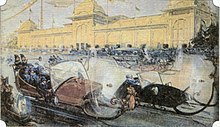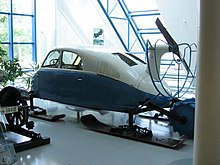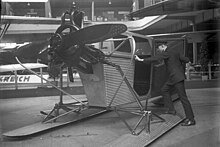Aerosani


Aerosani ( Russian Аэросани always in the plural, no singular form; air sled ), also known as propeller sleds , are snow vehicles with runners and propeller drives .
Aerosani were used by the Red Army in the Soviet-Finnish Winter War and World War II .
They drove on three to four runners and were equipped with a pusher propeller that was driven by an internal combustion engine. This means of transport was intended for locomotion on snow and ice. The speed was 25 to 140 km / h, depending on the strength of the engine and the load.
Air sleds (propeller sleds) were produced in the following countries: Russia, Soviet Union, Finland, Great Britain, Canada, Norway and Switzerland.
Beginnings
The first Aerosani were developed in 1903 and were widely used. The magazine "Wosduchoplawatel" (Russian Воздухоплаватель / Luftschiffer) reported in 1905 Sergej Neschdanowskij (Russian Сергей Сергеевич Неждановский ) as the inventor of this “sled with a snow screw for locomotion”. The first model was a light sled on which an internal combustion engine with a propeller was mounted. As early as 1907, a “ski car” by JA Meller (Russian Ю. А. Меллер ) was built and tested in the Moscow factory “Duks” , which he designed together with the engineer AD Dokuchayev (Russian А. Д. Докучаев ) would have. A year later this mobile was called Aerosani (Aero = air, Sani = sledge). The construction turned out to be very valuable for Russia with its limitless expanses, which are often snowed in over many months. A number of areas in northern Russia were only accessible through this mechanical transport sled.
production
In January 1910, Igor Sikorski, later known as an aircraft designer, tried out an Aerosani of his own design.
The first series production started in 1912, when a batch of transport sleds was manufactured in a Russian-Baltic factory on the order of the Russian War Ministry. At that time, other countries also turned their attention to air sleds, including France, Austria and Germany. When the First World War broke out, the Aerosani were also used on the front lines.
As early as the winter of 1914/15 they were used for reconnaissance, communication and other operational tasks. They were also used in the German army. Hindenburg recognized that the "snow automobiles" in Russia, with its very poorly developed road network, were an invaluable aid to the German troops.
That is why he closely followed the development work in this direction in the years before the war and was involved in the testing and introduction of the air sledges. In mid-1915, the "All-Russian District Association" (Russian Всероссийский земский союз , ВЗС for short; an organization of governorates and districts - Zemstva - which helped sick and wounded soldiers, founded on July 30, 1914 in Moscow, by liberal landlords and the rich urban upper class; part of the Semgor - Russian Земгор - the main committee responsible for supplying the Imperial Russian Army ) started the production of air sleds for the Russian front-line troops.
In the winter of 1915/16, 24 Aerosani were produced. The head of the automobile department of the “All-Russian District Association” NR Brilling, as well as the engineers of his department: AS Kusina and AA Arkhangelski, were involved in the design and manufacture . Some of these air sleds were equipped with a machine gun, the others were intended for the evacuation of the wounded. The use of these air sleds at the front showed that they can be used successfully in combat tasks, as well as for operational communication, the transport of ammunition and other transport tasks.
Civil war
During the Russian Civil War (1917/18 to 1920) some Aerosani, which had been built by the automobile department of the “All-Russian District Association”, were used by the Red Army . Propeller sleds were also used on the side of the interveners, in the Far East by the Japanese, in the north by the British. Even Kolchak troops in Siberia Aerosledges used.
In the winter of 1918/19, the Red Army's need for these all-terrain propeller sleds became particularly noticeable as rail transport became increasingly difficult. One of the most successful projects for a propeller sled was presented by engineer AS Kusin (Russian А. С. Кузин ). A commission was set up to assess its construction, including Nikolai Zhukovsky , Vladimir Wetschinkin , Boris Stetschkin and Andrei Tupolev .
At the suggestion of Zhukovsky, a commission was set up under the name “KOMPAS” (Russian “КОМПАС” ) to carry out scientific research into the creation of new types of propeller slides .
In September 1919 ten new propeller sleds were built. At the beginning of 1920, the series production of the propeller sled "Be-Ka" (Russian. "Бе-Ка" ) began, based on a design by Brilling and Kusin. Some of these propeller sleds were used at the front in combat operations. Three of these propeller sleds were used in the suppression of the Kronstadt sailors' uprising in 1921 . They were equipped with a machine gun and supported the attack of the Red Army on the fortress by drawing fire from the fortress batteries.
Production of different variants
After the Russian Civil War, the Aerosani continued to be manufactured. Until 1939 were from the design offices NAMI (russ. Центральный научно-исследовательский автомобильный и автомоторный институт - that a State Scientific Research Institute - / Central Scientific Research Institute for automobiles and automobile engines NII ) and ZAGI realized over 20 different models. The Department for the Construction of Gliding Boats and Aerosani (ОСГА / OSGA) created several variants of a propeller sled in 1932.
In 1934, this organization was converted into the special company "Lessudomaschstroj" (Russian "Лессудомашстрой" ), which began the series production of the propeller slides of the NKL series (Russian "НКЛ" ), the chief designer was NA Andrejew. From 1937 the NKL-16 was built and from 1941 the NKЛ-26, which was based on the NKL-6 (OSGA-6).
In the same year in Gorki (today Nizhny Novgorod ) in the plant "Red Metal Worker" (Russian: "Красный металлист" / Krassny metallist) production of the KM propeller slides was started, the chief designer was MW Weselowskij (Russian. М. В. Веселовский ).
During the Soviet-Finnish War (1939/40), the use of propeller sleds in the Red Army was widespread. These were mainly the series models ZAGI-ANT-IV (Russian ЦАГИ-АНТ-IV ; designer: Andrei Tupolew) and OSGA-NKL-6 (Russian ОСГА-НКЛ-6 ; designer: NA Andrejew). They were equipped with a machine gun mounted on a bogie. These propeller sleds took part in combat operations and were used for patrols in open terrain and for guarding tasks. Because of their great speed and maneuverability, the propeller sleds were very effective in detecting fire positions and correcting fire for the forward artillery observer . The propeller sleds NKL-6S (Russian НКЛ-6С ) were used especially for the fast transport of seriously injured persons , the "S" stands for "sanitarny" (medical). Furthermore, there was the NKL-38 especially for the work of the staff department and the NKL-12 for transport tasks at the field airfields , with which fuel was transported in barrels, as well as aircraft engines and aircraft parts.
German-Soviet War
Just a few days after the start of the German-Soviet War (1941 to 1945) on June 22, 1941, the Council for Labor and Defense (Russ. Совет Труда и Обороны ) set the Soviet industry the task of constructing reliable aerosani for combat and transport tasks and to begin series production at the beginning of winter in order to equip the Red Army for the coming winter.
At the same time, a special administration was created within the armored forces of the Red Army, which was responsible for the organization and equipment of special combat and transport aerosani units. The propeller sleds were mass-produced. In 1941 the first Aerosani battalions were set up and used for important tasks.
The new Combat Aerosani NKL-26 and RF-8 (Russian РФ-8 ) and the Transport Aerosani NKL-16/41 (41 stands) were produced according to drafts made under the direction of NM Andreev and MW Weselowskij for the 1941 model year) and later NKL-16/42 (42 stands for the 1942 model year). These models were handed over to combat and transport aerosani units and used in late December 1941 and January 1942. After the Battle of Moscow , German troops had to withdraw from Moscow in early 1942 after being defeated by the 16th Army of Soviet troops. The 16th Army deployed dozen of combat and transport aerosani battalions, commanded by Konstantin Rokossovsky . In his memoirs, Rokossowski often mentions the role of the aerosani. Since the 1960s, the Aerosani have transformed from a primitive mode of transportation to a rapidly evolving, sophisticated mode of transportation.
commitment
Aerosani were first used for military purposes in 1915, mainly as a means of transportation and communication. In the winter of 1939/40 the Red Army had some Aerosani detachments that were used in the operations against Finland, mainly for liaison purposes between its own units, the transport of ammunition, food, fuel and the wounded. Occasionally the Aerosani detachments carried out combat missions - they raided enemy troops, staffs and the enemy hinterland in a flash. The combat aerosani were usually followed by aerosani, who set down fighters on skis.
However, the Aerosani were used most frequently in the German-Russian War, especially in 1942/43. At this time they were first used in large numbers as a combat vehicle. Its effect was most successful in open terrain, on and on lakes ( Ladoga , Ilmensee , Seligersee ), on frozen rivers, in the Gulf of Finland and on the Baltic coast.
The Aerosani departments performed the following tasks:
- Aerosani combat battalions (Russian Боевые аэросанные батальоны ; short: басб / basb)
- military reconnaissance of the area and the enemy
- Guarding the open flanks of infantry and tank units
- Patrol duty to guard the lake shore, which was not directly occupied by the Red Army units
- Pursuit of the retreating enemy in cooperation with ski infantry units
- Guarding command points and ensuring communication
- Aerosani transport battalions (Russian Транспортные аэросанные батальоны ; short: тасб / tasb)
- Transport of units and evacuation of the wounded from the combat area
- Transport of cargo and weapons to the combat area
- Relocation and transport of machine gun fire positions, mortars and anti-tank cannons
- Patrol to guard sections not occupied by the Red Army
- Creation of a fog curtain
Civilian use in the Soviet Union in the 1950s to 1980s
The Aerosani Sewer-2 (Russian Север-2 / Nord-2) was designed in the Kamow experimental design office in 1959 , 100 of which were manufactured in series. In 1962, the “Progress” plant began series production of the even more sophisticated model Ka-30. The "Dalmaschsawod" plant (Russian Дальмашзавод ) produced 25 to 30 Aerosani annually from 1966 onwards. The Aerosani Ka-30 could take eight to ten passengers and were used for the regular transport of people and goods (especially mail). Aerosani were also used for medical care purposes in hard-to-reach areas of Siberia , the Far North and Kazakhstan, in order to cover greater distances.
The Aerosani have also proven their worth when the connection routes are in poor condition: snow, pack ice or temperatures below −40 ° C. The mileage of the Aerosani was 12,000 to 15,000 km per year. In the summer, the Aerosani were equipped with floats and used on rivers, on very shallow, otherwise non- navigable rivers - similar to a gliding boat . At the end of their lifespan , the Aerosani were decommissioned in the late 1980s.
disadvantage
Driving on very uneven terrain, forest trails and narrow roads is very difficult and sometimes impossible. Aerosani can move very slowly on narrow forest paths with frequent bends and steep climbs, on terrain with many tree stumps and thick branches on the ground or in areas with high shrub growth. In such terrain, the propellers or the runners often break. No use is possible during the snow and ice-free season.
Alternative means of transport for such difficult and inaccessible terrain are snowmobiles , hovercraft , swamp boats , off-road vehicles , amphibious vehicles , snow groomers , seaplanes , helicopters or ground-effect vehicles .
classification

- NKL: NKL-6; NKL-6S; NKL-12; NKL-16; NKL-16/41; NKL-16/42; NKL-26; NKL-34; NKL-38;
- RF-8-GAS-98 (Russian РФ-8-ГАЗ-98 or РФ-8 (ГАЗ-98) );
- Sewer-2;
- KA-30;
- KM-4;
- MS-1;
- ZAGI-ANT-IV;
- OSGA: OSGA (NKL) -6;
- ANT: ANT-IV;
- ASD-400;
- Arbes (Russian Арбес );
- NRB (Russian НРБ );
- Beka (Russian Бека ).
literature
- Steven J. Zaloga , James Grandsen: Soviet Tanks and Combat Vehicles of World War Two. London: Weidenfeld & Nicholson, 1984, pp. 185-187. ISBN 978-0-85368-606-4
Web links
- Article Soviet Combat Snowmobiles on battlefield.ru ( memento of July 29, 2013 in the Internet Archive )
Individual evidence
- ↑ Утро Росссiи. February 6 (January 24) 1910 (Russian; newspaper from 1910)
- ^ Konstantin Rokossowski: Soldatskij dolg. (Russian), Moscow 1968 (German soldier duty); ISBN 5-203-00489-7 (for the 1988 edition)


